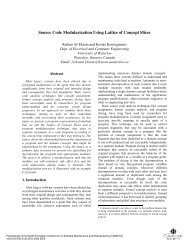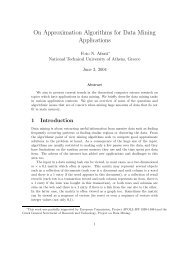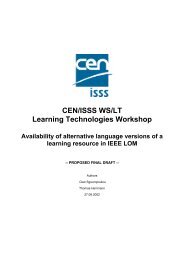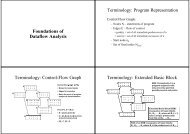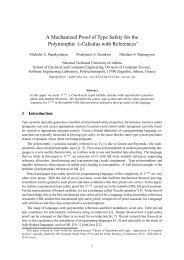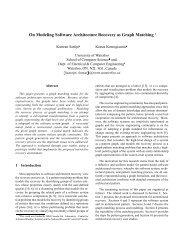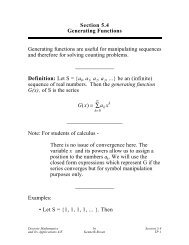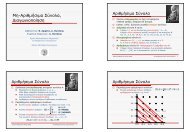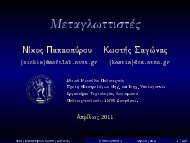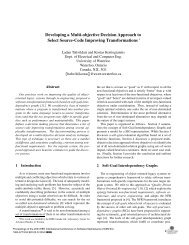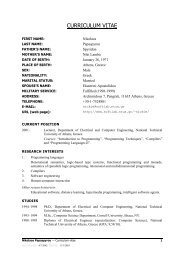Manual
Manual
Manual
Create successful ePaper yourself
Turn your PDF publications into a flip-book with our unique Google optimized e-Paper software.
Chapter 3: Bison Grammar Files 61<br />
This option also tells Bison to write the C code for the grammar actions into a file<br />
named ‘file.act’, in the form of a brace-surrounded body fit for a switch statement.<br />
%no-lines<br />
[Directive]<br />
Don’t generate any #line preprocessor commands in the parser file. Ordinarily Bison<br />
writes these commands in the parser file so that the C compiler and debuggers will<br />
associate errors and object code with your source file (the grammar file). This directive<br />
causes them to associate errors with the parser file, treating it an independent<br />
source file in its own right.<br />
%output="file"<br />
Specify file for the parser file.<br />
[Directive]<br />
%pure-parser<br />
[Directive]<br />
Request a pure (reentrant) parser program (see Section 3.7.10 [A Pure (Reentrant)<br />
Parser], page 58).<br />
%require "version"<br />
[Directive]<br />
Require version version or higher of Bison. See Section 3.7.1 [Require a Version of<br />
Bison], page 54.<br />
%token-table<br />
[Directive]<br />
Generate an array of token names in the parser file. The name of the array is yytname;<br />
yytname[i] is the name of the token whose internal Bison token code number is i.<br />
The first three elements of yytname correspond to the predefined tokens "$end",<br />
"error", and "$undefined"; after these come the symbols defined in the grammar<br />
file.<br />
The name in the table includes all the characters needed to represent the token in<br />
Bison. For single-character literals and literal strings, this includes the surrounding<br />
quoting characters and any escape sequences. For example, the Bison single-character<br />
literal ’+’ corresponds to a three-character name, represented in C as "’+’"; and<br />
the Bison two-character literal string "\\/" corresponds to a five-character name,<br />
represented in C as "\"\\\\/\"".<br />
When you specify %token-table, Bison also generates macro definitions for macros<br />
YYNTOKENS, YYNNTS, and YYNRULES, and YYNSTATES:<br />
YYNTOKENS<br />
YYNNTS<br />
YYNRULES<br />
YYNSTATES<br />
The highest token number, plus one.<br />
The number of nonterminal symbols.<br />
The number of grammar rules,<br />
The number of parser states (see Section 5.5 [Parser States], page 75).<br />
%verbose<br />
[Directive]<br />
Write an extra output file containing verbose descriptions of the parser states and<br />
what is done for each type of look-ahead token in that state. See Section 8.1 [Understanding<br />
Your Parser], page 89, for more information.



